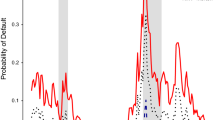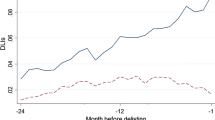Abstract
This article investigates the relationship between value premium and financial distress using a long US data set over 1927–2011. The measures of leverage and default are used as proxies for financial distress when applying a time-varying volatility methodology. The article examines the potential risk-based explanation for the source of the value premium. The empirical analysis shows that both the default premium and its volatility have positive explanatory power for the value premium and its volatility. The findings suggest a negative association between the lagged values of the default premium and the current small stocks value premium. Investigating the reasons behind this association uniquely uncovers an asymmetric correlation between returns on both value and growth stocks and default risk before and post July 1954 after a change in the monetary regime in the United States.


Similar content being viewed by others
Notes
Black (2006) investigates the relationship between default risk and value premium volatilities using quarterly data. Our analysis expands to investigate the association between the variables themselves in addition to their volatilities using longer and higher frequent set of data.
Elgammal and Al-Najjar (2013) report leverage effects in the monthly value premium in the US, Canada, Denmark, Finland, New Zealand, Sweden, the UK and Poland stock markets during the period of December 1991 to December 2006. The leverage effect is well documented in the literature (for more details and evidence, see Christie, 1982; Ivaschenko, 2003; Bollerslev et al, 2006; Penman et al, 2007).
Campbell et al (2008) argue that the previous researchers’ results for the returns on financial distressed stocks depend on the used measure of financial distress. For example, the low returns of distressed stocks are also documented by Dichev (1998), who uses Altman’s Z-score and Ohlson’s O-score to measure financial distress; Garlappi and Yan (2011), who obtain default risk measures from Moody’s KMV; and Avramov et al (2009), who use credit ratings to measure firms’ financial status. On the other hand, Vassalou and Xing (2004) find evidence that distressed stocks with a low distance to default have higher returns, but this evidence comes entirely from small value stocks.
As Penman et al (2007) mention, the Black-Scholes-Merton measure potentially uses more information compared with the O-score and Z-score measures, which are limited to accounting information. However, it is based on equity prices, introducing some concern as to whether inefficient prices are conjectured.
I thank Kenneth French for making the data available on his website: http://mba.tuk.dratmouth.edu/pages/ken.french/.
The Structural break tests of both Chow’ Breakpoint Test and The CUSUM Test, the cumulative sum of the recursive residuals (Brown et al, 1975); results are available on request.
Penman et al (2007) argue that this association is consistent with inverse relationship founded between future returns and wide variety of financial distress measures in different context. They introduce an extensive discussion for the work in this area (for example, they have interesting discussion for the work of Dichev, 1998; Griffin and Lemmon, 2002, and Campbell et al, 2008).
This period is described by NBER as the last expansion period in the US economy (NBER, 11 December 2008, http://www.nber.org/cycles/dec2008.pdf). The last liquidity period of July 2007 to June 2009 is included in the analysis but the results are not significant for this period. The results are available on request.
References
Akbas, F., Boehmer, E., Genc, E. and Petkova, R. (2010) The Time-Varying Liquidity Risk of Value and Growth Stocks. Texas, USA: Texas A&M University Business School.
Anderson, R., Sundaresan, S. and Tychon, P. (1996) Strategic analysis of contingent claims. European Economic Review 40 (3–5): 871–881.
Avramov, D., Chordia, T., Jostova, G. and Philipov, A. (2009) Credit ratings and the cross-section of stock returns. Journal of Financial Markets 12 (3): 469–499.
Bali, T.G. and Engle, R.F. (2010) The intertemporal capital asset pricing model with dynamic conditional correlations. Journal of Monetary Economics 57 (4): 377–390.
Black, A.J. (2002) The impact of monetary policy on value and growth stocks: An international evaluation. Journal of Asset Management 3 (2): 142–172.
Black, A.J. (2006) Macroeconomic risk and the Fama-French three-factor model. Managerial Finance 32 (6): 505–517.
Black, A.J., Fraser, P. and McMillan, D.G. (2007) Are international value premiums driven by the same set of fundamentals. International Review of Economics and Finance 16 (1): 113–129.
Black, A.J. and McMillan, D.F. (2006) Asymmetric risk premium in value and growth stocks. International Review of Financial Analysis 15 (3): 237–246.
Black, F., Jensen, M.C. and Scholes, M.S. (1972) The Capital Asset Pricing Model: Some Empirical Tests. Praeger Publishers. SSRN, http://ssrn.com/abstract=908569 Date posted: 13 June 2006.
Bollerslev, T. (1987) A conditionally heteroskedastic time series model for speculative prices and rates of return. The Review of Economics and Statistics 69 (3): 542–547.
Bollerslev, T., Chou, R.Y. and Kroner, K.F. (1992) ARCH modeling in finance: A review of the theory and empirical evidence. Journal of Econometrics 52 (1–2): 5–59.
Bollerslev, T., Litvinova, J. and Tauchen, G. (2006) Leverage and volatility feedback effects in high-frequency data. Journal of Financial Econometrics 4 (3): 353–384.
Bollerslev, T. and Wooldridge, J.M. (1992) Quasi-maximum likelihood estimation and inference in dynamic models with time-varying covariances. Econometric Reviews 11 (2): 143–172.
Brown, R.L., Durbin, J. and Evans, J.M. (1975) Techniques for testing the constancy of regression relationships over time. Journal of the Royal Statistical Society 37 (2): 149–163.
Campbell, J.Y., Hilscher, J. and Szilagyi, J. (2008) In search of distress risk. Journal of Finance LXIII (6): 2899–2939.
Chan, K.C. and Chen, N. (1991) Structural and return characteristics of small and large firms. Journal of Finance 46 (4): 1467–1484.
Chan-Lau, J.A. (2006a) Market-Based Estimation of Default Probabilities and its Application to Financial Market Surveillance. IMF Working Paper no. 06/104.
Chan-Lau, J.A. (2006b) Fundamentals-Based Estimation of Default Probabilities: A Survey. IMF Working Paper no. 06/149.
Chen, N. and Zhang, F. (1998) Risk and return of value stocks. The Journal of Business 71 (4): 501–535.
Choi, J. (2013) What drives the value premium?: The role of asset risk and leverage. Review of Financial Studies 26 (11): 2845–2875.
Christie, A. (1982) The stochastic behaviour of common stock variance: Value, leverage and interest rate effects. Journal of Financial Economics 10 (4): 407–432.
Crosbie, P. and Bohn, J. (2003) Modelling Default Risk: Modelling Methodology, Moody’s KMV, http://www.ma.hw.ac.uk/~mcneil/F79CR/Crosbie_Bohn.pdf, accessed 9 March 2013.
Dichev, I.D. (1998) Is the risk of bankruptcy a systematic risk? The Journal of Finance 53 (3): 1131–1147.
Elgammal, M. and Al-Najjar, B. (2013) The Leverage effect on the value premium volatility: From an international prospective, working capital, Working paper.
Engle, R.F. (1982) Autoregressive conditional heteroscedasticity with estimates of the variance of UK inflation. Econometrica 50 (4): 987–1008.
Fama, E.F. and French, K.R. (1989) Business conditions and expected returns on stock and bonds. Journal of Financial Economics 25 (1): 23–49.
Fama, E.F. and French, K.R. (1992) The cross-section of expected stock returns. The Journal of Finance 47 (2): 427–465.
Fama, E.F. and French, K.R. (1996) Multifactor explanations of asset pricing anomalies. Journal of Finance 51 (1): 55–84.
Fama, E.F. and French, K.R. (1998) Value versus growth: The international evidence. Journal of Finance 53 (6): 1975–1999.
Fama, E.F. and French, K.R. (2006) The value premium and the CAPM. The Journal of Finance LXI (5): 2163–2185.
Fama, E.F. and French, K.R. (2007) The anatomy of value and growth stock returns. Financial Analysis Journal 63 (6): 44–54.
Garlappi, L. and Yan, H. (2011) Financial distress and the cross section of equity returns. The Journal of Finance 66 (3): 789–822.
George, T. and Hwang, C. (2010) A resolution of the distress risk and leverage puzzles in the cross section of stock returns. Journal of Financial Economics 96 (1): 56–79.
Griffin, J.M. and Lemmon, M.L. (2002) Book-to-market equity, distress risk, and stock returns. Journal of Finance 57 (5): 2317–2336.
Ivaschenko, I. (2003) How Much leverage is Too Much, or Does Corporate Risk Determine the Severity of Recession? IMF Working Paper, New York, USA.
Li, X., Brooks, C. and Miffre, J. (2009) The value premium and time-varying volatility. Journal of Business Finance & Accounting 36 (9–10): 1252–1272.
Liu, B., Kocagil, A. and Gupton, G. (2007) Fitch Equity Implied Rating and Probability of Default Model. Fitch Ratings, http://www.defaultrisk.com/_pdf6j4/Fitch_Equity_Implied_Rtng_n_Prbblty_o_Dflt_Mdl.pdf.
Liu, W. (2006) A liquidity augmented capital asset pricing model. Journal of Financial Economics 82 (3): 631–671.
Merton, R.C. (1974) On the pricing of corporate debt: The risk structure of interest rates. Journal of Finance 29 (2): 449–470.
Mohanram, P.S. (2005) Separating winners from losers among low book-to-market stocks using financial statement analysis. Review of Accounting Studies 10 (2): 133–170.
Molina, C.A. (2005) Are firms underleveraged? An examination of the effect of leverage on default probabilities. Journal of Finance 60 (3): 1427–1459.
Ng, J. (2005) Distress Risk Information in Accruals. Working Paper, The Wharton School, University of Pennsylvania.
Penman, S.H., Richardson, S.A. and Tuna, I. (2007) The book-to-price effect in stock returns: Accounting for leverage. Journal of Accounting Research 45 (2): 427–468.
Piotroski, J.D. (2000) Value investing: The use of historical financial information to separate winners from losers. The Journal of Accounting Research 38 (Supplement, 2000): 1–41.
Scislaw, K. and McMillan, D.G. (2012) The search for an exploitable value premium in market indexes. Journal of Asset Management 13 (4): 253–270.
Vassalou, M. (2003) News related to future GDP growth as a risk factor in equity returns. Journal of Financial Economics 68 (1): 47–73.
Vassalou, M. and Xing, Y. (2004) Default risk in equity returns. Journal of Finance 59 (2): 831–868.
Watanabe, A. and Watanabe, M. (2008) Time-varying liquidity risk and the cross-section of stock returns. Review of Financial Studies 21: 2449–2486.
Zhang, L. (2005) The value premium. Journal of Finance 60 (1): 67–103.
Acknowledgements
The authors thank Angela Black, Ercan Balaban, Ken Peasnell, David Shepherd, Alison Rieple, Linda Clarke, Petia Petrova, the participants at the 2008 ICAS/BAA Accounting & Finance Scot-doc Conference in Glasgow and the 2013 BAFA conference in Newcastle as well as Panagiotis Dontis-Charitos, Ben Nowman, Sheeja Sivaprasad, Stefan Van Dellen and all other participants at a 2011 research seminar of Westminster Business School in London for their useful comments and advice on earlier versions of this article. Furthermore, we are grateful to the anonymous referees from the World Finance Conference, Rhodes (Greece), June (2011) for accepting the article in the conference and for their helpful comments. The authors alone are responsible for all limitations and errors that may relate to the article.
Author information
Authors and Affiliations
Corresponding author
Additional information
1has worked for the past 18 years in Egypt, the United Kingdom and Qatar Academia. He has worked in International Commercial Bank, Menoufia University, Aberdeen University, Westminster University and Qatar University. He has many publications in different areas of finance, including Financial Predictors of Credit Ratings, Liquidity Crisis, Financial Distress, market anomalies, corporate governance, bank performance and macroeconomic risk factors. He has been awarded research grant from different internationally respected organizations, including Qatar University, Egyptian Government, Suez Canal University, Economic and Social Research Council and Qatar National Research Foundation.
Rights and permissions
About this article
Cite this article
Elgammal, M., McMillan, D. Value premium and default risk. J Asset Manag 15, 48–61 (2014). https://doi.org/10.1057/jam.2014.10
Received:
Revised:
Published:
Issue Date:
DOI: https://doi.org/10.1057/jam.2014.10




